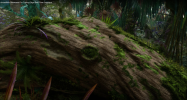ARK SE just uses lots of environmental assets that look very generic when put together as a whole. Objectively, it looks very good, but it speaks to the power of UE5 that many others could do the same thing. Artistically, it lacks anything that distinguishes it. And that's very critical for a game's identity and for its graphics to be something of note, in my opinion.Agreed on the polish being important, although I would disagree that Ark SA visually looks janky. Ark SE was 100% in the "followed some UE4 tutorials" space, but Ark SA art and graphics are actually quite good on average. The lack of polish in Ark SA is more in the edge cases... there are certain times of day where you get boiling from indirect lighting, there's flicker in certain shadows, and the animations are kind of inconsistent. And there's obviously still jank gameplay but that's as much a feature for Ark players as a detriment(although I have no idea why anyone plays Ark PVP).
Have you played both on max settings PC or just watched videos curiously? I'm surprised folks who had tried both would say that to be honest as the difference is fairly obvious even to a non-enthusiast (ex. my wife). That's not to take anything away from Avatar in particular, they are just aiming at a different target on the quality/performance curve. And indeed as I noted Avatar scales down quite a bit better; I haven't looked up console comparisons but I'm sure it looks better than Ark SA console which is merely "ok".
Subjective quality aside though, I'm just not entirely sure what new and exciting stuff is happening on the tech side in Avatar at first glance. Guess it will be interesting to hear about it at future GDC's, etc.
And similarly I wouldn't say Ark SA is necessarily some great demo of what AAA folks will come up with UE5, but performance aside I do think it is a pretty impressive game visually.
It's impressive yea, but I would also completely understand why somebody would look at Avatar and think it's overall a more noteworthy accomplishment. Especially since Massive are using their own engine and achieving such great results.


